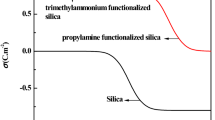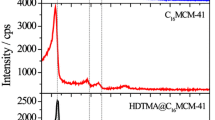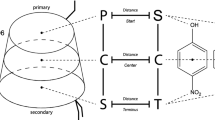Abstract
Confinement in mesoporous silica can greatly increase the solubility of pharmaceutical compounds. Propionic acid derivatives (a very popular class of drugs that include ibuprofen and ketoprofen) would greatly benefit from such technology, given their common apolar character. However, it is still debated whether, after confinement, these drugs are adsorbed on the pore walls as individual molecules or they keep the H-bonded dimeric structure that exists in their crystalline form. Their physical state inside the mesopores could have important consequences on the final performances of the drug delivery system. We employed accurate periodic density functional theory simulations, both static and dynamic, to investigate the issue. We simulated ibuprofen, as a model for all propionic acid derivatives, adsorbed both as a monomer and as a dimer inside a realistic model for the MCM-41 mesoporous silica. We found that adsorption is energetically favored in both cases, driven by both vdW and H-bond interactions. However, through ab initio molecular dynamics, we observed a continuous forming, breaking and reforming of these interactions. In the end, by comparing computed energetics, vibrational spectra and mobility, we were able to provide some important clues on the physical state of this class of drugs inside mesoporous silica, helping to define which drug family (monomer or dimer) is more probable after confinement.








Similar content being viewed by others
References
Kresge CT, Leonowicz ME, Roth WJ et al (1992) Ordered mesoporous molecular sieves synthesized by a liquid-crystal template mechanism. Nature 359:710–712
Kresge CT, Roth WJ (2013) The discovery of mesoporous molecular sieves from the twenty year perspective. Chem Soc Rev 42:3663–3670
Ciesla U, Schüth F (1999) Ordered mesoporous materials. Microp Mesop Mater 27:131–149
Corma A (1997) From microporous to mesoporous molecular sieve materials and their use in catalysis. Chem Rev 97:2373–2419
Anselmo AC, Mitragotri S (2014) An overview of clinical and commercial impact of drug delivery systems. J Control Release 190:15–28
Fahr A, Liu X (2007) Drug delivery strategies for poorly water-soluble drugs. Expert Opin Drug Deliv 4:403–416
Vallet-Regi M, Rámila A, Del Real RP, Pérez-Pariente J (2001) A new property of MCM-41: drug delivery system. Chem Mater 13:308–311
Vallet-Regí M, Balas F, Arcos D (2007) Mesoporous materials for drug delivery. Angew Chem Int Ed 46:7548–7558
Katzung BG (2007) Basic and clinical pharmacology. McGraw-Hill Medical, New York
Beetge E, du Plessis J, Müller DG et al (2000) The influence of the physicochemical characteristics and pharmacokinetic properties of selected NSAID’s on their transdermal absorption. Int J Pharm 193:261–264
Rimola A, Costa D, Sodupe M et al (2013) Silica surface features and their role in the adsorption of biomolecules: computational modeling and experiments. Chem Rev 113:4216–4313
Delle Piane M, Corno M, Ugliengo P (2013) Does dispersion dominate over H-bonds in drug-surface interactions? The case of silica-based materials as excipients and drug-delivery agents. J Chem Theory Comput 9:2404–2415
Delle Piane M, Corno M, Pedone A et al (2014) Large-scale B3LYP simulations of ibuprofen adsorbed in MCM-41 mesoporous silica as drug delivery system. J Phys Chem C 118:26737–26749
Delle Piane M, Vaccari S, Corno M, Ugliengo P (2014) Silica-based materials as drug adsorbents: first principle investigation on the role of water microsolvation on ibuprofen adsorption. J Phys Chem A 118:5801–5807
Shankland N, Wilson CC, Florence AJ, Cox PJ (1997) Refinement of ibuprofen at 100 K by single-crystal pulsed neutron diffraction. Acta Cryst 53:951–954
Briard P, Rossi JC (1990) Ketoprofene. Acta Crystallogr Sect C 46:1036–1038
Flippen JL, Gilardi RD (1975) +)-2-(2-Fluoro-4-biphenyl)propionic acid (flurbiprofen. Acta Crystallogr Sect B 31:926–928
Brás AR, Noronha JP, Antunes AMM et al (2008) Molecular motions in amorphous ibuprofen as studied by broadband dielectric spectroscopy. J Phys Chem B 112:11087–11099
Azais T, Tourne-Peteilh C, Aussenac F et al (2006) Solid-state NMR study of ibuprofen confined in MCM-41 material. Chem Mater 18:6382–6390
Guenneau F, Panesar K, Nossov A et al (2013) Probing the mobility of ibuprofen confined in MCM-41 materials using MAS-PFG NMR and hyperpolarised-129Xe NMR spectroscopy. Phys Chem Chem Phys 15:18805–18808
Bras AR, Merino EG, Neves PD et al (2011) Amorphous ibuprofen confined in nanostructured silica materials: a dynamical approach. J Phys Chem C 115:4616–4623
Dovesi R, Orlando R, Erba A et al (2014) CRYSTAL14: a program for the ab initio investigation of crystalline solids. Int J Quantum Chem 114:1287–1317
Orlando R, Delle Piane M, Bush IJ et al (2012) A new massively parallel version of CRYSTAL for large systems on high performance computing architectures. J Comput Chem 33:2276–2284
Hutter J, Iannuzzi M, Schiffmann F, Vandevondele J (2014) Cp2 k: atomistic simulations of condensed matter systems. Wiley Interdiscip Rev Comput Mol Sci 4:15–25
Lee C, Yang W, Parr RG (1988) Development of the Colle-Salvetti correlation-energy formula into a functional of the electron density. Phys Rev B 37:785–789
Becke AD (1993) Density-functional thermochemistry. III. The role of exact exchange. J Chem Phys 98:5648–5652
Stephens PJ, Devlin FJ, Chabalowski CF, Frisch MJ (1994) Ab initio calculation of vibrational absorption and circular dichroism spectra using density functional force fields. J Phys Chem 98:11623–11627
Dovesi R, Saunders VR, Roetti C et al (2014) CRYSTAL14, User’s Manual. Università di Torino, Torino, Italy
Monkhorst HJ, Pack JD (1976) Special Points for Brillouin-Zone Integration. Phys Rev B 8:5188–5192
Saunders VR, Hillier IH (1973) A “Level–Shifting” method for converging closed shell Hartree–Fock wave functions. Int J Quantum Chem 7:699–705
Grimme S (2006) Semiempirical GGA-type density functional constructed with a long-range dispersion correction. J Comput Chem 27:1787–1799
Civalleri B, Zicovich-Wilson CM, Valenzano L, Ugliengo P (2008) B3LYP augmented with an empirical dispersion term (B3LYP-D*) as applied to molecular crystals. CrystEngComm 10:405–410
Nada R, Nicholas JB, McCarthy MI, Hess AC (1996) Basis Sets for ab initio Periodic Hartree–Fock Studies of Zeolite/Adsorbate Interactions: He, Ne, and Ar in Silica Sodalite. Int J Quantum Chem 60:809–820
Schäfer A, Horn H, Ahlrichs R (1992) Fully optimized contracted Gaussian basis sets for atoms: Li to Kr. J Chem Phys 97:2571
Broyden CG (1970) The convergence of a class of double-rank minimization algorithms 1. General considerations. IMA J Appl Math 6:76–90
Bernhard Schlegel H (1984) Estimating the hessian for gradient-type geometry optimizations. Theor Chim Acta 66:333–340
Boys SF, Bernardi F (1970) The calculation of small molecular interactions by the differences of separate total energies. Some procedures with reduced errors. Mol Phys 19:553–566
VandeVondele J, Krack M, Mohamed F et al (2005) Quickstep: fast and accurate density functional calculations using a mixed Gaussian and plane waves approach. Comp Phys Comm 167:103–128
Perdew JP, Burke K, Ernzerhof M (1996) Generalized gradient approximation made simple. Phys Rev Lett 77:3865–3868
Goedecker S, Teter M, Hutter J (1996) Separable dual space Gaussian pseudo-potentials. Phys Rev B 54:1703–1710
VandeVondele J, Hutter J (2007) Gaussian basis sets for accurate calculations on molecular systems in gas and condensed phases. J Chem Phys 127:114105
Bussi G, Donadio D, Parrinello M (2007) Canonical sampling through velocity rescaling. J Chem Phys 126:014101
Ugliengo P, Sodupe M, Musso F et al (2008) Realistic models of hydroxylated amorphous silica surfaces and MCM-41 mesoporous material simulated by large-scale periodic B3LYP calculations. Adv Mater 20:4579–4583
Coasne B, Ugliengo P (2012) Atomistic model of micelle-templated mesoporous silicas: structural, morphological, and adsorption properties. Langmuir 28:11131–11141
Vueba ML, Pina ME, Batista de Carvalho LAE (2008) Conformational stability of ibuprofen: assessed by DFT calculations and optical vibrational spectroscopy. J Pharm Sci 97:845–859
Freer AA, Bunyan JM, Shankland N, Sheen DB (1993) Structure of (S)-(+)-ibuprofen. Acta Cryst C 49:1378–1380
Gashi Z, Censi R, Malaj L et al (2009) Differences in the interaction between aryl propionic acid derivatives and poly(vinylpyrrolidone) K30: a multi-methodological approach. J Pharm Sci 98:4216–4228
Ugliengo P, Viterbo D, Chiari G (1993) MOLDRAW: molecular graphics on a personal computer. Z Krist 207:9–23
Humphrey W, Dalke A, Schulten K (1996) VMD: visual molecular dynamics. J Mol Graph 14:33–38
Acknowledgments
Models have been visualized and manipulated by MOLDRAW [48] and VMD [49]. Figures have been rendered with the Tachyon ray tracer, built into VMD. The vast majority of the calculations have been carried out thanks to the PRACE (PaRtnership for Advanced Computing in Europe) project pra50810 “Mesoporous silica for drug delivery: a quantum mechanical simulation” (20 million CPU hours on SuperMUC, LRZ, Munich, Germany). CRYSTAL developers are acknowledged for providing up to date development versions of the code and fruitful advice.
Author information
Authors and Affiliations
Corresponding author
Additional information
Published as part of the special collection of articles “CHITEL 2015 - Torino - Italy”.
Rights and permissions
About this article
Cite this article
Delle Piane, M., Corno, M. & Ugliengo, P. Propionic acid derivatives confined in mesoporous silica: monomers or dimers? The case of ibuprofen investigated by static and dynamic ab initio simulations. Theor Chem Acc 135, 53 (2016). https://doi.org/10.1007/s00214-016-1817-9
Received:
Accepted:
Published:
DOI: https://doi.org/10.1007/s00214-016-1817-9




